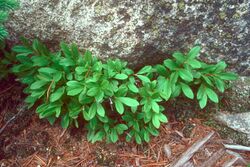Biology:Vaccinium cespitosum
| Vaccinium cespitosum | |
|---|---|

| |
| Scientific classification | |
| Kingdom: | Plantae |
| Clade: | Tracheophytes |
| Clade: | Angiosperms |
| Clade: | Eudicots |
| Clade: | Asterids |
| Order: | Ericales |
| Family: | Ericaceae |
| Genus: | Vaccinium |
| Species: | V. cespitosum
|
| Binomial name | |
| Vaccinium cespitosum Michx. 1803
| |
| Synonyms[2] | |
| |
Vaccinium cespitosum (also, caespitosum), known as the dwarf bilberry, dwarf blueberry, or dwarf huckleberry, is a species of flowering shrub in the genus Vaccinium, which includes blueberries, huckleberries, and cranberries.
Description

Vaccinium cespitosum is a low-lying plant rarely reaching half a meter (1.5 feet) in height which forms a carpet-like stand in rocky mountainous meadows. The dwarf bilberry foliage is reddish-green to green and the flowers are tiny urn-shaped light pink cups less than a centimeter (>0.4 inches) wide.[3] It has many somewhat angled branches. It forms low mats as it spreads on runners or stolons. The flowers are waxy, bell-shaped, and have five united petals. Unlike true blueberries, which flowers are in clusters , the flowers always occur singly. The bloom period is between the months of May to June, where they are pollinated by bees and flies. The dark blue fruit are on the plant by late-summer. The berries also have a whitish bloom. There are many seeds in the fruit.[4]
The fruits are edible blue bilberries.[3] Both grizzly and black bears, and also humans, like eating the fruit. It is a host of the butterfly species Lycaeides idas nabokovi.[4]
Distribution and habitat
Vaccinium cespitosum is widespread across much of Canada including all three Arctic territories, as well as the northern and western United States, Mexico, and Guatemala.[5][3][6] Its native habitats include gravelly or rocky meadows and mountain slopes.[7] In the Great Lakes area, it is usually found in savannas or conifer forests. Where bilberry is common, it can be found at higher elevations and in spruce-fir forest. It can also be found in alpine heath and in shrublands.[4]
See also
References
- ↑ "NatureServe Explorer 2.0". https://explorer.natureserve.org/Taxon/ELEMENT_GLOBAL.2.156947/Vaccinium_caespitosum.
- ↑ "Vaccinium caespitosum". Tropicos. Missouri Botanical Gardens. http://www.theplantlist.org/tpl1.1/record/tro-12300045.
- ↑ 3.0 3.1 3.2 Vander Kloet, Sam P. (2009), "Vaccinium cespitosum", in Flora of North America Editorial Committee, Flora of North America North of Mexico (FNA), 8, New York and Oxford, http://www.efloras.org/florataxon.aspx?flora_id=1&taxon_id=250065710
- ↑ 4.0 4.1 4.2 "Dwarf Bilberry". https://www.fs.usda.gov/wildflowers/plant-of-the-week/vaccinium_cespitosum.shtml.
- ↑ "Vaccinium caespitosum", State-level distribution map from the North American Plant Atlas (NAPA) (Biota of North America Program (BONAP)), 2014, http://bonap.net/MapGallery/State/Vaccinium%20caespitosum.png
- ↑ CONABIO. 2009. Catálogo taxonómico de especies de México. 1. In Capital Nat. México. CONABIO, México D.F.
- ↑ "Lady Bird Johnson Wildflower Center - The University of Texas at Austin". https://www.wildflower.org/plants/result.php?id_plant=VACE.
External links
- Jepson Manual Treatment: Vaccinium cespitosum
- United States Department of Agriculture Plants Profile: Vaccinium cespitosum
Wikidata ☰ Q4116550 entry
 |


